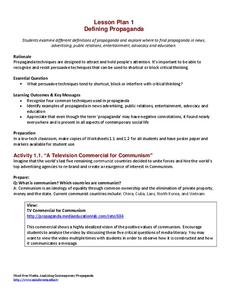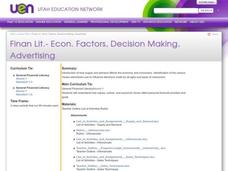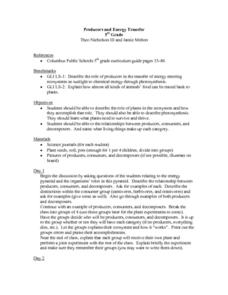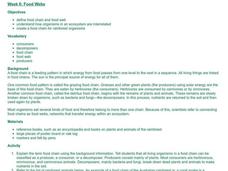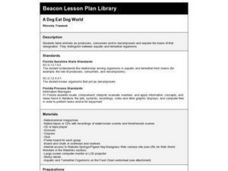Curated OER
Grocery Shopping
Using an adaptive shopping list, special needs students take a trip to the grocery store. Instead of words, their list contains pictures of the items they need to find and purchase at the store. They run through several practice and...
Curated OER
To Dorm or Not To Dorm
For some of our students, college is right around the corner. Provide a bit of thoughtful information to help them (and their families) decide if dorm life is right for them. Included here are a list of pros and cons for living both on...
Federal Reserve Bank
Prices: The Marketplace’s Communication System
Explore the dual role of prices as signals and incentives, and discover how prices are determined by buyers and sellers in the United States economy.
Classroom Law Project
Should we believe everything we read? Becoming a discerning consumer of media
Class members investigate the role media should play in a healthy democracy. As part of this study, groups analyze political advertising, use FactCheck to assess not only the veracity of but the persuasions techniques used in candidates'...
Bill of Rights Institute
Post-WWII Boom: Transition to a Consumer Economy
The war is over! Scholars investigate an AP review video to uncover the post-WWII era in the United States. Viewers examine and analyze the consumerism that arose in post-war America. This is the eighth installment of a nine-part...
Rice University
Principles of Microeconomics for AP® Courses 2e
An informational textbook covers key principles related to microeconomics, such as consumer behavior and using models to understand economic issues. Young scholars also complete self-check questions at the end of each section to check...
EngageNY
Mid-Unit 3 Assessment Part 1: Researching Information about Buying Fish Caught Using Sustainable Methods
Sustainable seafood is not an oxymoron. Pupils watch a video about how consumers purchase seafood responsibly. Then, using resources in their assessment research folders, they complete a graphic organizer to record factual information...
Curated OER
Chapter 2: The Economizing Problem
It doesn't take a lecture on economics to convince teenagers that one's wants often exceed one's means, but this presentation will hopefully help them to understand the discrepancy. Using an example of pizza and robot arms, the slides...
Media Education Lab
Defining Propaganda
21st century learners live in a media world. Help them develop the skills they need to be able to analyze the barrage of propaganda they face daily, with a resource that introduces them to the type of persuasive appeals found in...
Curated OER
Food Chains and Webs
For this food chains worksheet, learners identify the producers and consumers in the given food chains and describe how contaminants can biologically accumulate. This worksheet has 4 short answer questions.
Curated OER
Demand Shifters
Students explore concept of demand and factors that cause demand for a good or service to change; students recognize factors that influence their behavior as consumers. Real world examples are provided through an interview with William...
Curated OER
Finan Lit.- Econ. Factors, Decision Making, Advertising
Students are able to understand how supply and demand affects the economy and consumers. They introduced to how supply and demand affects the economy and consumers. Students use a rational decision-making process to set and implement...
Curated OER
Arctic Food Web
Students research animals found in the arctic. They discuss what living things need in order to survive and where they get their food. Students discuss the difference between producers and consumers and create a food web for animals in...
Curated OER
Who Is Eating Whom?
Pupils discuss the food chain and identify if various organisms are producers or consumers. They draw ten types of organisms and construct a food web of these organisms, labelling each as a producer or consumer.
Curated OER
Producers and Energy Transfer
Fifth graders discuss the relationship between producers, consumers, and decomposers as they look at the energy pyramid. While working in small groups, they create an ecosystem that includes all or some of the given categories, and they...
Curated OER
Food Webs
Students research rainforest animals and use that information to make a flow chart to show the order in which energy is transferred through several organisms. They label the producers, consumers, and decomposers in their chart.
Curated OER
Food Chains
Learners investigate the food chain. In this ecology lesson plan, students define producers and consumers. Learners use organism cards to demonstrate how the food chain works.
Curated OER
Forest Appreciation
Learners gain appreciation for the value of the forest. In this forest instructional activity, students discuss the benefits of forests and their products. They play a kinesthetic game about the consumers of the forest.
Curated OER
Getting to Know the Products from Trees
In this tree products lesson, young scholars read the book Tell Me,Tree: All About Trees for Kids, discuss how people make products from wood, define producers and consumers and then go on a treasure hunt for wood products at home and...
Curated OER
Are things Really More Expensive Today?
Learners explore the topics of inflation and deflation within the economy. The Consumer Price Index is used to contrast the price of goods today with that of years past.
Curated OER
Lemonade Stand
Learners plan a lemonade stand to compete with another stand and examine their decisions from the consumer and producer's point of view. They discuss the law of supply and demand, plan for their lemonade stand, and write an essay...
Curated OER
Constructing A Food Web
Students identify and explain the relationships within a food web. They use index cards to glue pictures of producers and consumers. On the back of the card, students name the organism, list the type of biome in which it is found.
Curated OER
A Dog Eat Dog World
Fourth graders distinguish between acquatic and terrestrial organisms. They label animals as producers, consumers, and/or decomposers.
Curated OER
Insect Travel Brochure
Seventh graders study producers and consumers in habitats. They examine the trophic levels and how different organisms interact with a focus on insects. They create a travel brochure for an insect to visit a habitat which they create.
Other popular searches
- Consumer Math
- Consumer Science
- Consumer Economics
- Consumerism
- Consumer Issues
- Family and Consumer Sciences
- Producers and Consumers
- Producer Consumer Decomposer
- Producer Consumer Economics
- Consumer Math Worksheets
- Consumer Awareness Slogans
- Family & Consumer Science








